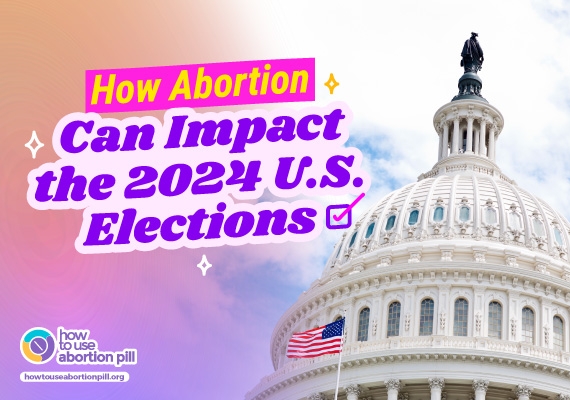While November is still 8 months away, there is already a ton of chatter about the 2024 U.S. elections and what might be at stake. Among the many issues on voters’ and candidates’ minds is the one of reproductive rights and freedoms, including abortion.
After Roe v. Wade, the historic Supreme Court ruling that guaranteed women and other pregnant people’s right to abortion, was struck down in June 2022, nearly half of the country (mostly conservative states in the South) took advantage of the new political context to pass restrictions that make it harder (and sometimes even impossible) to get abortions. Among the most controversial restrictions is Florida’s 6-week abortion ban, which essentially eliminates access since most pregnant people wouldn’t even know they were pregnant in time for the procedure. In Texas, too, abortion is banned except to save the life of the pregnant person, a very narrow legal exception that is difficult to navigate, often forcing doctors to forego medically necessary abortions for fear they could be arrested.
The current political landscape surrounding reproductive rights.
It’s not just abortion that some states are attacking, but other reproductive freedoms as well, like assisted reproductive technology (in-vitro fertilization). Just last month, the Alabama Supreme Court ruled that frozen embryos should be considered children, making it illegal to destroy them. In essence, this ruling effectively stopped doctors from performing IVF treatments, destroying the dreams of thousands of would-be parents waiting to undergo their IVF transfer, sometimes after years of fertility treatments.
And while birth control currently remains legal and protected by two major Supreme Court decisions, Republicans and anti-choice advocates are also trying to chip away at this freedom. In Oklahoma, the legislature is considering a bill that would require a prescription for emergency contraception and could also restrict access to IUDs. Other states are also looking at ways to restrict access to emergency contraception, some of which are patently cruel in both their intent and consequence—Iowa, for example, recently decided to stop covering the cost of emergency contraception for sexual assault survivors.
But even amid this red wave of restrictions, the U.S. has also seen blue bubbles of protection, with states that have added constitutional amendments and other policies that decidedly safeguard the right to abortion and birth control. And many political observers say that Democratic wins in the 2022 midterms and some state races since then can be attributed to voter dissatisfaction with the overturning of Roe and the Republicans’ response to restrict reproductive freedom.
Potential Impact on Voter Turnout
Democrats are banking on voters to show their dissatisfaction again at the ballot box in November, voting against what they call a Republican agenda to restrict women’s and pregnant people’s reproductive rights and freedom, bringing the country backwards. Some polling data suggests they are correct in their prediction—a December 2023 Reuters/Ipsos poll revealed 7 in 10 Americans said protecting abortion access in their state would be an important issue to their vote in November, including 2/3 of Independent voters who said the same. In fact, the Democratic National Committee’s Chairman, Jaime Harrison, recently said that Donald Trump and his supporters’ “cruel vision for America” basically guarantees Democratic triumph in November, believing that voters, including moderate Republicans, will be motivated to come out and vote against things like reproductive health restrictions.
But is the idea that voters will come out in droves to show their opposition to reproductive health restrictions realistic? While it’s true the Republican Party is somewhat split on the restrictions, when forced to choose, more than three-quarters say they are pro-life, according to the Gallup Poll. And while many Americans are indeed opposed to the restrictions, that doesn’t necessarily translate into votes at the ballot box. In fact, some may remember that it was this exact logic—that there is no way Americans would co-sign on “extreme” positions—that propelled Donald Trump to victory against Hillary Clinton in 2016. Yes, many Americans oppose the restrictions on reproductive freedom, but is that enough to turn voters out in November?
Political leaders and advocates for reproductive health should not assume that the abhorrence of the restrictions passed since the fall of Roe will motivate voters to turn out on Election Day without concerted efforts to actually turn them out. And in addition to convincing voters to vote against the conservative agenda, leaders might also provide a reason to vote for issues like protecting reproductive freedom. 2024 represents an opportunity to capitalize on the reproductive health issue, but the opportunity requires a lot of groundwork from now until November.
Conclusion
If you or anyone you know is interested in joining the fight to uphold reproductive rights during this election, here are a few things you can do:
-
- Organize or join educational and advocacy campaigns
- Share personal stories to humanize reproductive rights.
- Political engagement that encourages voters to research a candidate’s stance on reproductive rights.
- Collaborate with allies to build a bigger platform and recruit more allies.
- Highlight the economic impact of reproductive rights on people.
Looking for abortion support in a restricted state? You can reach out to carafem, AidAccess and womenonweb for assistance.
Brittany L. Stalsburg is a writer and researcher in the New York City metro area of the U.S. While she works across a number of categories, her focus and passion lie in the social impact space, including for organizations that focus on marginalized populations.
